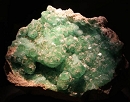
|
| Smithsonite |
Chemical
Formula |
ZnCO3 |
Species |
Carbonates |
Crystal
System |
Trigonal |
Mohs
Scale |
4 |
Specific
Gravity |
4.4-4.5 |
Color |
White, grey, yellow, green to apple-green, blue, pink, purple, bluish grey, and brown |
Streak |
White |
Luster |
Vitreous, Pearly |
Refractive
Index |
n = 1.842 - 1.850 n = 1.619 - 1.623 |
Diaphaneity |
Translucent |
Cleavage |
Very GoodOn . |
Fracture |
Irregular/Uneven, Sub-Conchoidal |
| Crystal Habit:Uncommon as crystals, typically botryoidal, reniform, spherulitic; stalactitic, earthy, compact massive |
| Geological Setting:Oxidised zones of zinc ore deposits. |
Smithsonite, or
zinc spar, is zinc carbonate (ZnCO
3), a mineral ore of zinc. Historically, smithsonite was identified with hemimorphite before it was realised that they were two distinct minerals. The two minerals are very similar in appearance and the term calamine has been used for both, leading to some confusion. The distinct mineral smithsonite was named in 1832 by Fran?ois Sulpice Beudant in honor of English chemist and mineralogist, James Smithson (c.1765-1829), whose bequest established the Smithsonian Institution and who first identified the mineral in 1802.
Smithsonite is a variably colored trigonal mineral which only rarely is found in well formed crystals. The typical habit is as earthy botryoidal masses. It has a Mohs hardness of 4.5 and a specific gravity of 4.4 to 4.5.
Smithsonite occurs as a secondary mineral in the weathering or oxidation zone of zinc-bearing ore deposits. It sometimes occurs as replacement bodies in carbonate rocks and as such may constitute zinc ore. It commonly occurs in association with hemimorphite, willemite, hydrozincite, cerussite, malachite, azurite, aurichalcite and anglesite. It forms two limited solid solution series, with substitution of manganese leading to rhodochrosite, and with iron, leading to siderite.


 YueGongAnBei 44051102000467
YueGongAnBei 44051102000467


 |
|